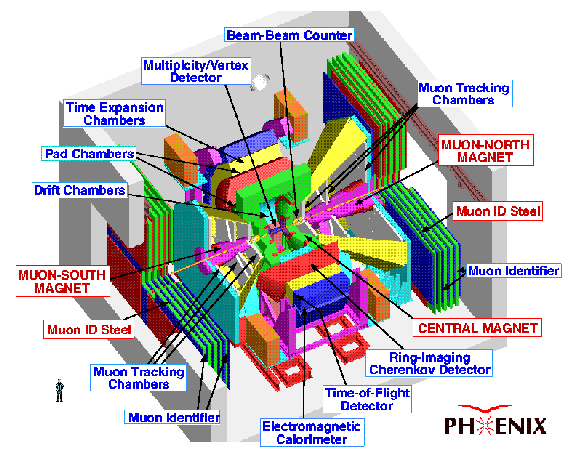 ) and
North and South Muon Arms (
) and
North and South Muon Arms ( ).
).



The PHENIX detector system is one of the major detector systems at
RHIC [6] and shown in Figure 1.
The system comprises three parts; Central Arm ( ) and
North and South Muon Arms (
) and
North and South Muon Arms ( ).
).
In the Central Arm, finely granulated
EM calorimeter ( ) is installed.
Because of high granuality, a single
photon will be clearly discriminated against
the two photons from neutral meson decays at least up to
) is installed.
Because of high granuality, a single
photon will be clearly discriminated against
the two photons from neutral meson decays at least up to  =25 GeV/c.
=25 GeV/c.
Each Muon Arm consists of muon magnet,
muon tracking system, and muon identifier.
The muon magnet produces radial magnetic field.
The tracking chambers located
at three stations measure the deflection angle,
thus the momentum of the charged
particles. The muon identifier consists of hadron-absorber steel plates and
panels of Iarocci tubes.
Because of the absorbers in front of and behind the muon
tracking system,
the hadron rejection of order 10 is expected
according to GEANT [7] based simulations.
The momentum resolution of
the muon arm has been also studied using GEANT based
simulation, and found to be about 2% at 10 GeV/c.
is expected
according to GEANT [7] based simulations.
The momentum resolution of
the muon arm has been also studied using GEANT based
simulation, and found to be about 2% at 10 GeV/c.
In the sensitivity studies of our measurements, the geometrical acceptance is fully taken into account. Since study of the efficiencies are still ongoing, the experimental efficiencies (detection efficiency, track finding efficiency, and so on) are assumed to be 100% to give a basis of further studies.

Figure: Schematic view of PHENIX detector system.


